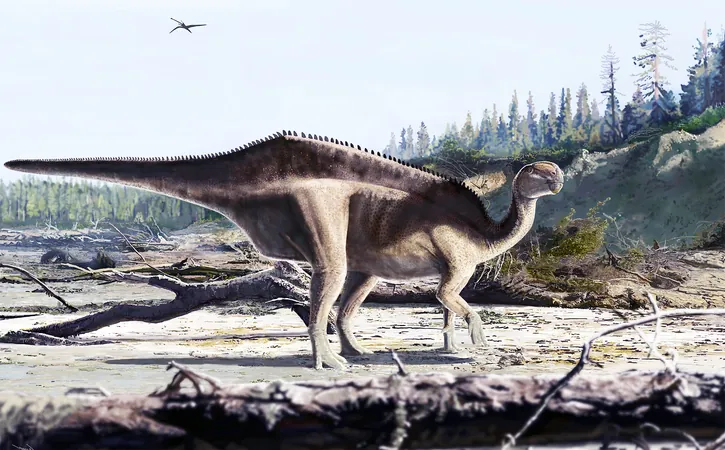
Meet the Eye-Catching Dinosaur Whose Sail Was All About Love!
2025-08-26
Author: Wei Ling
For millions of years, dinosaurs have left their bones behind, waiting to be uncovered in Earth’s rocky embrace. A stunning newcomer has emerged from this ancient world: the Istiorachis, discovered on England’s Isle of Wight.
This isn’t just another standard dinosaur; it’s a vibrant plant-eater sporting a gigantic sail that stretches fantastically down its back and tail. Living around 125 million years ago, this creature's sail wasn’t for swimming or soaring through the skies—no, it was likely a dazzling display of vanity!
Unearthing the Unseen: The Discovery of Istiorachis
For years, the bones of this fascinating dinosaur lay quietly at the Dinosaur Isle Museum, misclassified alongside more commonplace species. That is until Jeremy Lockwood, a retired doctor turned Ph.D. researcher at the University of Portsmouth and the Natural History Museum in London, decided to take a closer look.
Lockwood observed something extraordinary about the spinal column. "While the skeleton wasn’t as complete as others, it stood out due to its unusually long neural spines. No one had really examined these bones closely before," he explained.
A Sail for Show, Not for Function
As Lockwood continued his analysis, it became obvious that this dinosaur was anything but ordinary. The long spine bones created a sail-like structure, and while one might guess its purpose involved temperature regulation or fat storage, that doesn’t appear to be the case.
"Evolution sometimes favors the fantastic over the functional," Lockwood said. After much debate, researchers lean towards the idea that these features were all about visual signaling—likely playing a crucial role in courtship displays.
Just as modern reptiles flaunt impressive sails predominantly for mating rituals, Istiorachis seemingly did the same, using its extravagant sail to impress potential partners!
Delving Deeper: Tracing the Evolution of the Sail
The researchers didn't stop at examining fossils; they went all-in with a comprehensive database of dinosaur spinal structures, compiling images, illustrations, and direct measurements. They even created an iguanodontian family tree to reveal how spine size evolved historically.
Lockwood elaborated, "These methods allowed us to go beyond mere description of the fossil and actually test hypotheses about its function. We found that the spines of Istiorachis were not just tall; they were exaggerated compared to most Iguanodon-like species—an attribute likely shaped by sexual selection."
A Name to Remember: Istiorachis macarthurae
This captivating dinosaur has gained a name: Istiorachis macarthurae. The title translates to "sail spine," while the latter part honors Dame Ellen MacArthur, a renowned solo sailor from the Isle of Wight.
The Isle of Wight: A Dinosaur Goldmine!
The Isle of Wight has been a treasure trove of dinosaur discoveries, unveiling species like Brighstoneus, Comptonatus, and fierce predators like Riparovenator and Ceratosuchops. Each find paints a picture of a vibrant ecosystem where diverse species coexisted.
According to researchers, Istiorachis adds yet another layer to this fascinating narrative while hinting at broader dinosaur evolutionary trends.
Neural spine elongation began in the Late Jurassic, but hyper-elongation—where the spine is four times taller than the vertebra—remains relatively rare. The connection between Istiorachis and modern lizards suggests these evolutionary pressures continue today.
Dusty Bones, New Discoveries!
Remarkably, this discovery didn’t take place in the field; it emerged from a detailed examination of fossils tucked away in museum collections. Lockwood’s meticulous research has quadrupled our knowledge of smaller iguanodontians from the Isle of Wight over the last five years.
As paleontologist Susannah Maidment noted, "Jeremy’s work revives the history of iguanodontian dinosaurs on the Isle of Wight, showcasing that substantial knowledge about Early Cretaceous ecosystems remains to be unearthed."
These fossils originate from the Wessex Formation, one of the richest sources of Early Cretaceous land creatures globally. This era marked a pivotal shift in dinosaur history, transitioning from relative obscurity in the Jurassic to dominating the herbivore scene in the Late Cretaceous.
For now, Istiorachis macarthurae stands tall—not just for its impressive sail but as a testament to the surprises still lurking in dusty museum collections. Who knows what other secrets await in the shadows of the past?
Stay tuned for the full study published in the journal Papers in Palaeontology!



 Brasil (PT)
Brasil (PT)
 Canada (EN)
Canada (EN)
 Chile (ES)
Chile (ES)
 Česko (CS)
Česko (CS)
 대한민국 (KO)
대한민국 (KO)
 España (ES)
España (ES)
 France (FR)
France (FR)
 Hong Kong (EN)
Hong Kong (EN)
 Italia (IT)
Italia (IT)
 日本 (JA)
日本 (JA)
 Magyarország (HU)
Magyarország (HU)
 Norge (NO)
Norge (NO)
 Polska (PL)
Polska (PL)
 Schweiz (DE)
Schweiz (DE)
 Singapore (EN)
Singapore (EN)
 Sverige (SV)
Sverige (SV)
 Suomi (FI)
Suomi (FI)
 Türkiye (TR)
Türkiye (TR)
 الإمارات العربية المتحدة (AR)
الإمارات العربية المتحدة (AR)